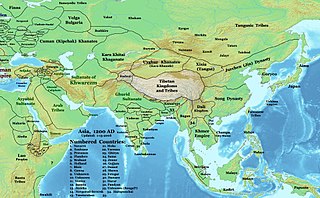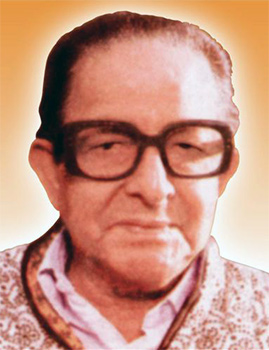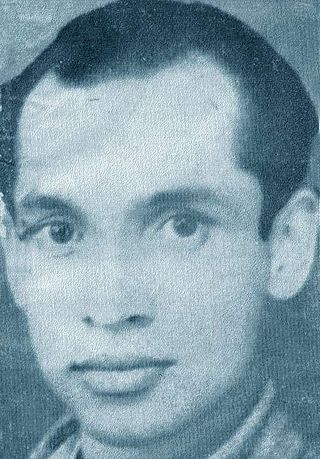
Malayalam, the lingua franca of the Indian state of Kerala and the union territories of Lakshadweep and Puduchery, is one of the six classical languages of India. Malayalam literature comprises those literary texts written in Malayalam, a South-Dravidian language spoken in the Indian state of Kerala. The first travelogue in any Indian language is the Malayalam Varthamanappusthakam, written by Paremmakkal Thoma Kathanar in 1785. Malayalam literature has been presented with 6 Jnanapith awards, the second-most for any Dravidian language and the third-highest for any Indian language.
Indian epic poetry is the epic poetry written in the Indian subcontinent, traditionally called Kavya. The Ramayana and the Mahabharata, which were originally composed in Sanskrit and later translated into many other Indian languages, and the Five Great Epics of Tamil literature and Sangam literature are some of the oldest surviving epic poems ever written.
Indian literature refers to the literature produced on the Indian subcontinent until 1947 and in the Republic of India thereafter. The Republic of India has 22 officially recognised languages.

Kannada literature is the corpus of written forms of the Kannada language, a member of the Dravidian family spoken mainly in the Indian state of Karnataka and written in the Kannada script.

Telugu literature is the body of works written in the Telugu language. It consists of poems, short stories, novels, plays, and song lyrics, among others. There is some indication that Telugu literature dates at least to the middle of the first millennium, the first extant works are from the 11th century when the Mahabharata was first translated to Telugu from Sanskrit by Nannaya. The language experienced a golden age under the patronage of the Vijayanagara king-poet Krishnadevaraya.

Assamese literature is the entire corpus of poetry, novels, short stories, plays, documents and other writings in the Assamese language. It also includes the literary works in the older forms of the language during its evolution to the contemporary form and its cultural heritage and tradition. The literary heritage of the Assamese language can be traced back to the c. 9-10th century in the Charyapada, where the earliest elements of the language can be discerned.

Hoysala literature is the large body of literature in the Kannada and Sanskrit languages produced by the Hoysala Empire (1025–1343) in what is now southern India. The empire was established by Nripa Kama II, came into political prominence during the rule of King Vishnuvardhana (1108–1152), and declined gradually after its defeat by the Khalji dynasty invaders in 1311.

Mysore literature in Kannada is a body of literature composed in the Kannada language in the historical Kingdom of Mysore in Southern India and written in the Kannada script. The writings date from the Kingdom of Mysore, which existed from around 1600 CE until the establishment of modern India in 1947. Many of the works of this literature written on religious themes are labeled Veerashaiva or Vaishnava in acknowledgment of the two faiths that gave form to the literature and fostered it until the advent of the modern era. Despite a gradual decline in the popularity of Jainism, authors devoted to the faith produced some works of merit. Secular themes dealing with a wide range of subjects were also written on. Kannada literature flourished for a short while in the court of the neighbouring kingdom of the Nayakas of Keladi whose territory was annexed by Mysore in 1763.
Odia literature is literature written in the Odia language, mostly from the Indian state of Odisha. The modern Odia language is mostly formed from Tadbhava words with significant Sanskrit (Tatsama) influences, along with loanwords from Desaja, English, Hindustani (Hindi/Urdu), Persian, and Arabic. Its earliest written texts date from around 1000 CE. The earliest Odia newspaper was Utkala Deepika, first published on August 4, 1866.

Vijayanagara literature in Kannada is the body of literature composed in the Kannada language of South India during the ascendancy of the Vijayanagara Empire which lasted from the 14th through the 16th century. The Vijayanagara empire was established in 1336 by Harihara I and his brother Bukka Raya I. Although it lasted until 1664, its power declined after a major military defeat by the Shahi Sultanates in the battle of Talikota in 1565. The empire is named after its capital city Vijayanagara, whose ruins surround modern Hampi, now a World Heritage Site in Karnataka.

Nabakanta Barua was a prominent Assamese novelist and poet. He was also known as Ekhud Kokaideu. As Sima Dutta he wrote many poems in his early life.

Amulya Barua was a pioneer of modern Assamese poetry. He was born at Jorhat on 30 June 1922. In 1941, he passed matriculation examination from Jorhat Govt. Boys' H.S and M.P. School with letter marks in Assamese and got himself admitted into the prestigious Cotton College at Guwahati. But unavoidable domestic problem compelled him to return home and he took admission into JB College at Jorhat. In 1945 he passed his B.A. examination from Jagannath Barooah College, Jorhat. Then he went to Calcutta for higher studies and admitted into the MA class of Calcutta University. Barua was killed in the infamous communal violence of Bengal in 1946 along with many of his hostel mates at Raja Ram Narayan Street, Calcutta.

Jagannatha Dasa (1728–1809), a native of Manvi town in the Raichur district, Karnataka state, India, comes in the preceptorial line of Madhvacharya and is considered one of the notable Haridasa of Dvaita Vedanta of Madhva saint-poets of the Kannada language. Apart from authoring numerous well-known devotional songs that propagate the Vaishnava bhakti ("faith") of Dvaita Vedanta of Madhvacharya, Jagannatha Dasa wrote the Harikathamritasara in the native shatpadi metre and Tattva suvali in the native tripadi metre. He was also an accomplished scholar in the Sanskrit language.
Champu or Chapu-Kavya is a genre of literary composition in Indian literature. The word 'Champu' means a combination of poetry and prose. A champu-kavya consists of a mixture of prose (Gadya-Kavya) and poetry passages (Padya-Kavya), with verses interspersed among prose sections.
Asaga was a 9th-century Digambara Jain poet who wrote in Sanskrit and Kannada language. He is most known for his extant work in Sanskrit, the Vardhamana Charitra. This epic poem which runs into eighteen cantos was written in 853 CE. It is the earliest available Sanskrit biography of the last tirthankara of Jainism, Mahavira. In all, he authored at least eight works in Sanskrit. In Kannada, none of his writings, including the Karnataka Kumarasambhava Kavya that have been referenced by latter day poets have survived.
Nilmani Phookan was an Indian poet in the Assamese language and an academic. His work, replete with symbolism, is inspired by French symbolism and is representative of the genre in Assamese poetry. His notable works include Surya Henu Nami Ahe Ei Nodiyedi, Gulapi Jamur Lagna, and Kobita.
Bhattadeva (1558–1638)(অসমীয়া: বৈকুণ্ঠনাথ ভাগৱত ভট্টাচাৰ্য), is acknowledged as the father of Assamese prose. Though Bhaktiratnakar-katha, the Assamese translation of Sankardev's Sanskrit composition Bhaktiratnakar by Gopala Charana Dwija preceded the works of Bhattadeva, Bhattadeva's prose had an influence in the development of a high and dignified style. Bhattadeva's and Gopala Charana Dvija's 16th century works are considered to be the earliest examples of prose in Indian languages. Bhattadeva's erudition in Sanskrit grammar and literature, and his command over the Bhagavata earned him the title of Bhagavata Bhattacharya.

Nalini Bala Devi was an Indian writer and poet of Assamese literature, known for nationalistic as well as mystical poetry. She was awarded the Padma Shri by the Government of India in 1957 for her contribution to literature, and 1968 she won the Sahitya Akademi Award given by Sahitya Akademi for her poetry collection Alakananda. She is the first woman Assamese poet to be awarded with Padma Shri and the first lady to the chair the Assam Sahitya Sabha.
Ananda Chandra Barua (1907–1983) was a writer, poet, playwright, translator, journalist and actor from Assam. He is popularly known as Bokulbonor Kobi in Assamese literacy society. He was honoured with, most notably the Padma Shri title and Sahitya Akademi award.










